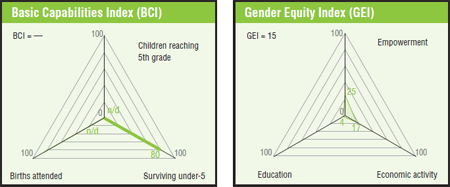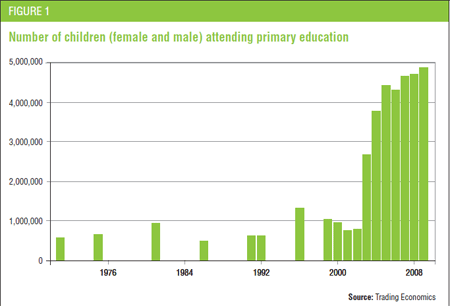No sustainable development without peace and security
Watch on Basic Rights Afghanistan Organization (WBRAO)
Coordination of Humanitarian Assistance (CHA)
Sanayee Development Organization (SDO)
Decades of armed conflict and unrest have almost destroyed Afghanistan’s institutions and territory. Although the country has a new Government and a new Constitution, it faces major challenges in terms of sustainable development. One of these is how to ensure the right to education for both females and males. Despite remarkable progress in rebuilding the education system, the Government’s efforts have been insufficient and much remains to be done. Other challenges include tackling environmental problems and rehabilitating and managing the country’s natural resources.
 |
After decades of war and civil unrest Afghanistan faces multiple challenges, among them poverty and lack of security. Armed conflicts resulted in more than 1.5 million casualties and a nearly dismantled education system. In September 2000, when the Millennium Summit was held at the UN General Assembly in New York, the country was still war-torn and could not participate. The Government subsequently endorsed the eight Millennium Development Goals (MDGs) in March 2004 but had to modify the global timetable and benchmarks because of its lost decades and the lack of available information. Although the rest of the international community determined the MDGs should be attained by 2015 against a baseline of 1990, Afghanistan set its targets for 2020 and its baselines between 2002 and 2005.[1] The Government also stated that peace and security play a critical role in achieving the MDGs and added “enhanced security” as a ninth goal;[2] indeed, peace and security are key components of sustainable development and any kind of long-term planning.
Advances in education
For a long time Afghanistan had very low rates of school attendance and high percentages of illiteracy. This situation became worse under Taliban rule: schools were closed and destroyed, curricula were restricted and women were banned from education. Between 1996 and 2001 women and girls were excluded from all aspects of educational life, from primary school to university, as schools for girls were closed and female teachers were prevented from working.[3] Girls’ gross enrolment ratio in Kabul fell from 32% in 1995 to just 6.4% in 1999.[4] The Taliban also imposed many restrictions on educational institutions and demanded that religion be emphasized at the expense of other subjects.[5]
After this educational and social collapse the country is slowly on the road to recovery, with a significant enrolment of students since the new Government took office. In the first years following the fall of the Taliban, education was a top priority for the Government as well as for donors, with a focus on getting children back into school with a particular emphasis on the primary level.[6] The Government is also striving to achieve MDG 3 (“to promote gender equality and empower women”) and has committed to eliminating gender disparity in all levels of education by 2020. The new Constitution states that education should be free for all Afghan nationals with no discrimination based on gender.
 |
Research by 16 local organizations led by Oxfam Novib shows that although there are still significant obstacles to girls’ education there has also been progress since 2001.[7] The “Back to School” campaign launched in 2002 significantly expanded primary school enrolment, which has shown a seven-fold increase from approximately 900,000 in 2000 to 5 million in 2008 (see also chart 1).[8] For girls, the boost has been even more dramatic: official enrolment figures have increased from an estimated 5,000 under the Taliban to 2.4 million girls as of 2010.[9]
According to figures published by UNICEF, between 2005 and 2009 the primary school attendance ratio was 66% for males and 40% for females while the figures for secondary school were 18% for males and 6% for females. The secondary school enrolment rate, on the other hand, was 41% for males and 15% for females.[10]
Efforts made to improve education in Afghanistan, however, are now beginning to slow down. The Ministry of Education has undoubtedly made progress in improving both the availability and quality of education, but due to the large influx of students over the past few years it is struggling to keep pace with demand. With donors increasingly focused on stabilization and counterinsurgency rather than development, and with security deteriorating in many areas of the country, the gains made in improving girls’ education are in danger of slipping away.
Parents and students are eager for high quality education but they are increasingly frustrated by the lack of progress. If there is not significant investment in post-primary education there is the risk that these students “will be left behind, turned off, perhaps, and cut short in their personal, social and vocational development.”[11]
Education and gender equality
According to an OXFAM report published in 2011, only 6% of Afghan women aged 25 or older have ever received any formal education and just 12% of women aged 15 or older are literate.[12] Of those interviewed for the report 41.2% named poverty as the single biggest obstacle to girls’ access to education and 39.4% stated that early or forced marriage was another barrier. Among the other challenges regarding gender equality in education are: [13]
- There are not enough female teachers to meet the demand. More than a quarter (26.4%) of the individuals interviewed for the research named the lack of a female teacher as a major obstacle to girls’ access to education. More than two-thirds of teachers (68.4%) reported that their school does not have enough teachers. Of these, more than half (54.6%) stated that they only needed both female and male teachers, 12.3% said they only needed male teachers and 5.7% were unsure.
- There are not enough education centres to meet the demand. Nearly a quarter (23.7%) of those interviewed saw distance from school as a major obstacle to girls’ access to education. Distance, along with attendance in mixed classes or interaction with male teachers, becomes increasingly problematic as girls approach adolescence and when cultural norms regulating their behaviour become more restrictive.
- Many schools do not have the infrastructure needed to provide quality education. Data from the Ministry of Education shows that 47% of schools lack proper facilities.[14] These varied significantly across research sites and were particularly deficient in rural areas.
Lack of security, female seclusion, religious biases, household chores and threats from the insurgents are key factors for girls abandoning schools. Acid and gas attacks on girl students in 2010 caused a number of dropouts; however new hope for an increase in girls’ enrolment emerged after the Taliban announced that they would not burn schools or create obstacles to girls’ education.[15]
Environmental issues
After 30 years of political chaos and conflict Afghanistan faces a severe environmental crisis. The major challenges are soil degradation, air and water pollution, deforestation, overgrazing, desertification, overpopulation in urban areas and poor management of fresh water resources.[16] Military factions have used wood extensively for fuel and also cleared forests to prevent them from being used as hiding places for the opposing forces.[17] Uncontrolled logging of the eastern conifer forests is having a severe impact on forest area conditions.[18]
As forest cover disappears, the risk of environmental degradation increases. Poor management of forests leads to desertification and soil erosion, which both inevitably reduce the amount of land available for agriculture.[19] If this trend is not reversed, and if the Government does not enforce a sustainable development model, the loss of agricultural land will negatively affect food security in the near future.
Extreme weather and natural disasters have also had a negative impact. The 1998–2003 drought, for example, created food shortages that drove major rural-to-urban migrations.[20] In 2008 conditions worsened: widespread losses of rain-fed wheat crops were reported due to a significant scarcity of rainfall and winter snowfall and thus wheat production fell significantly.[21] The same conditions were forecast for 2011. Low levels of rainfall mean that crops cannot be sustained and cause population displacement, a scenario that is bound to happen again if precipitation – as forecast – drops below normal parameters.[22]
Over 80% of Afghanistan’s water resources originate in the Hindu Kush Mountains but the larger glaciers in that region and the Pamir Mountains have shrunk by 30% and some smaller ones have vanished.[23] More than 2.5 million people in the country are already affected by drought or are vulnerable to the effects of recurrent drought and water shortages. This number is likely to increase due to global warming and further aridization.[24]
Conclusion
A new approach is urgently needed from both the Government and donors if the gains made in education are to be maintained. Decision-making around whether or not girls should go to school is based on a variety of factors that differ from province to province and even from household to household. There is also a complex relationship between demand factors (e.g., community attitudes and economic constraints) and supply factors (e.g., school buildings and qualified teachers). All these issues need to be addressed in order to increase girls’ attendance in school.[25]
The environmental crisis in Afghanistan is of major concern. Meeting the challenge will take decades and it cannot be tackled by the Government alone. Sustained financial assistance and technical support are also needed from the international community.[26]
[1] UNDP Afghanistan, Afghanistan MDGs overview, <www.undp.org.af/MDGs/index.htm>.
[2] Ibid.
[3] BBC World Service, Case study: education in Afghanistan, <www.bbc.co.uk/worldservice/people/features/ihavearightto/four_b/casestudy_art26.shtml>.
[4] American Institutes for Research with Hassan Mohammad, Education and the role of NGOs in emergencies, Afghanistan 1978–2002, (US Agency for International Development, 8 August 2006), <pdf.usaid.gov/pdf_docs/PNADG858.pdf>.
[5] BBC World Service, op. cit.
[6] Oxfam International, “High stakes: Girls’ education in Afghanistan,” Joint NGO Briefing Paper, (Oxford: Oxfam GB, 24 February 2011), <www.oxfam.org/en/policy/high-stakes-girls-education-afghanistan>.
[7] The Human Rights Research and Advocacy Consortium, Report card: Progress on Compulsory Education grades 1–9, (March 2004), <www.oxfamamerica.org/publications/afghanistan-education-report-card>.
[8] Islamic Republic of Afghanistan Ministry of Education, 1388 (2009–10) school attendance, (2010), unpublished spreadsheet.
[9] Ibid., 1388 (2009–10) school enrolment by grade, (2010), unpublished spreadsheet.
[10] UNICEF, Afghanistan: Statistics, <www.unicef.org/infobycountry/afghanistan_statistics.html>.
[11] J.K. Intili and E. Kissam, How to do more, faster: The current status of Afghanistan’s education system and a strategy to increase service capacity while improving learning,” (Aguirre Division, JBS International, September 2008), <www.eurasiacritic.com/articles/how-do-more-faster-current-status-afghanistan’s-education-system-and-strategy-increase>.
[12] Oxfam International, op. cit.
[13] Ibid.
[14] Islamic Republic of Afghanistan Ministry of Education, 1388 (2009–10) schools infrastructure, 2010, unpublished spreadsheet.
[15] Graeme Paton, “Taliban “abandons” opposition to girls’ education”, The telegraph, (14 January 2011), <www.telegraph.co.uk/news/worldnews/asia/afghanistan/8258146/
Taliban-abandons-opposition-to-girls-education.html>.
[16] Afghanistan online, Environmental facts and issues concerning Afghanistan, <www.afghan-web.com/environment>.
[17] Wikipedia, Environmental issues in Afghanistan, <en.wikipedia.org/wiki/Environmental_issues_in_Afghanistan>.
[18] UNEP, Afghanistan: Post-conflict environmental assessment, (Nairobi, Kenya: 2003), <postconflict.unep.ch/publications/afghanistanpcajanuary2003.pdf>.
[19] Ibid.
[20] Wikipedia, op. cit.
[21] US Department of Agriculture, Foreign Agricultural Service, Afghanistan: Severe drought causes major decline in 2008/2009 wheat production, (12 August 2008), <www.pecad.fas.usda.gov/highlights/2008/08/Afghanistan Drought>.
[22] M. Ryan, “Hungry Afghanistan faces prospect of drought in 2011,” Reuters, (11 February 2011), <www.reuters.com/article/2011/02/11/us-afghanistan-drought-feature-idUSTRE71A2Y820110211>.
[23] National Environmental Protection Agency of the Islamic Republic of Afghanistan (NEPA), Afghanistan’s Environment 2008, (NEPA and UNEP, 2008), <postconflict.unep.ch/publications/afg_soe_E.pdf>.
[24] Ibid.
[25] Oxfam International, op. cit.
[26] UNEP, Afghanistan’s environmental recovery: A post-conflict plan for people and their natural resources, (Geneva: UNEP Post-Conflict Branch), <postconflict.unep.ch/publications/UNEP_afghanistan_lr.pdf>.
| Attachment | Size |
|---|---|
| afghanistan2012_eng.pdf | 198.92 KB |